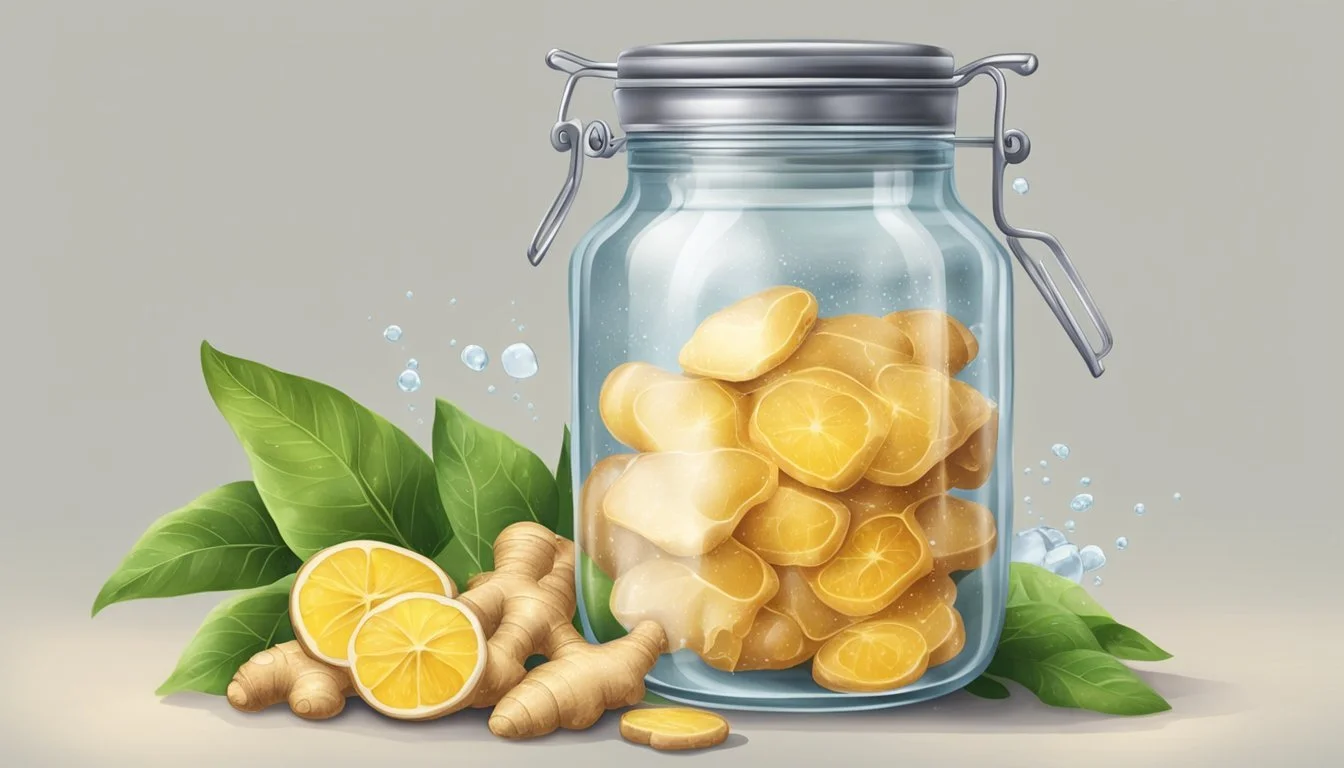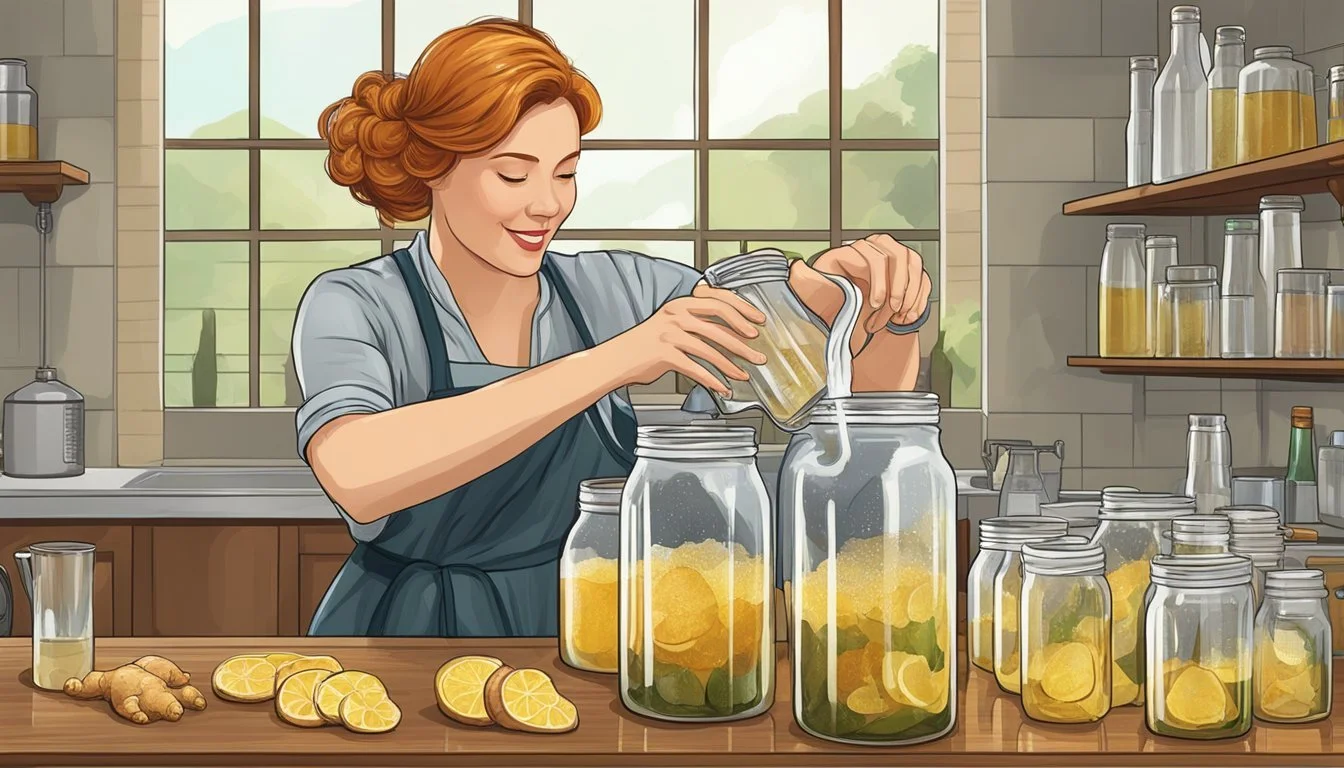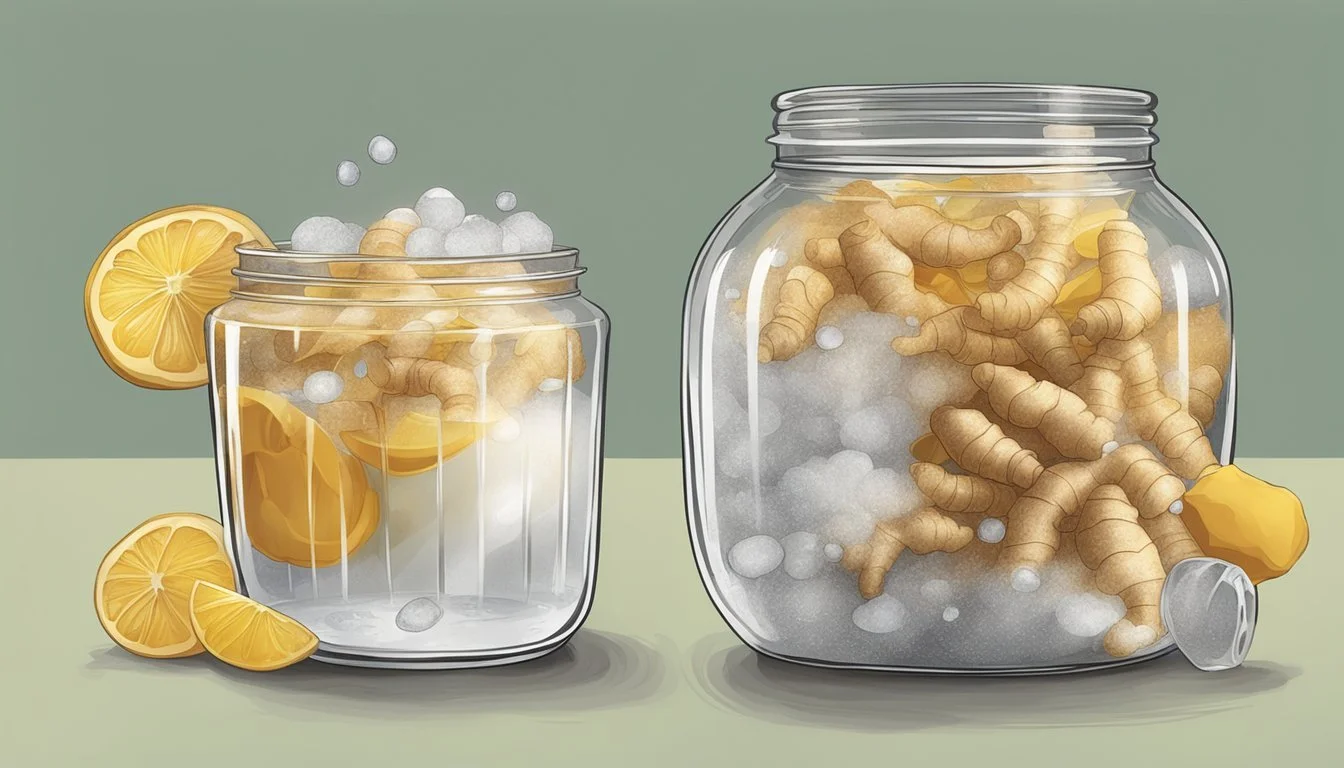How to Ferment Ginger Beer Traditionally
Mastering the Craft at Home
Traditional ginger beer is a naturally fermented beverage known for its invigorating spice and mild effervescence. This homemade drink, rooted in time-honored techniques, harnesses the power of natural fermentation to create a refreshingly tangy and slightly sweet drink with a notable ginger kick. Traced back to the colonial era, the process of crafting ginger beer centers around the symbiotic culture of bacteria and yeast, which thrives on ginger and sugar to produce its characteristic flavor and carbonation.
Creating traditional fermented ginger beer at home is a straightforward task that involves just a few key ingredients: fresh ginger, sugar, water, and time. By using a "ginger bug" — a simple concoction of grated ginger, sugar, and water that has been allowed to ferment and capture wild yeasts and bacteria — the brewer can initiate the fermentation process in a natural and organic way, avoiding the use of commercial yeasts. This method aligns with a sustainable approach to making beverages, relying on the naturally occurring microbes in the ginger skin and surrounding environment to ferment the concoction.
This deliberately cultivated ecosystem inside the ginger beer offers not only a complex flavor profile but also a variety of beneficial bacteria, contributing to its reputation as a probiotic-rich refreshment. Unlike commercial counterparts that often contain artificial carbonation and preservatives, homemade ginger beer represents a healthier alternative, albeit with the trade-off of a lower alcohol content, typically below 1% ABV. As a homemade craft, the brewer has the flexibility to adjust sweetness, potency of ginger flavor, and level of carbonation, yielding a unique and personal beverage each batch.
Understanding Fermentation
Fermentation is a natural metabolic process that is crucial for the production of traditional ginger beer. It involves the conversion of sugars into alcohol and carbon dioxide (CO2) through the action of yeast and wild yeasts, resulting in the beverage's characteristic fizz and flavor.
Basics of Fermentation
Fermentation is an age-old process utilized for preserving food and creating various beverages. Essential to fermentation is the metabolic action of microorganisms. In the context of fermenting ginger beer, the goal is to provide an environment where these organisms can thrive and produce desired changes in the liquid. The primary outputs of this process are:
Alcohol (Ethanol): Although ginger beer is a mildly alcoholic beverage, the alcohol content is typically low due to short fermentation periods.
Carbon Dioxide (CO2): Responsible for the effervescence, the bubbly texture of fermented ginger beer.
The typical steps in the fermentation process are as follows:
Mix ingredients (ginger, water, sugar, and lemon) in a fermentation vessel.
Introduce yeast, either a ginger bug or commercial yeast.
Allow the mixture to ferment in a warm environment.
The mixture is stirred regularly to distribute yeast and nutrients.
Role of Yeast and Wild Yeasts
Yeast, both cultivated and wild varieties, are microscopic fungi that play a pivotal role in fermentation. Saccharomyces cerevisiae is a commonly used cultivated yeast in fermentation due to its reliability and predictable results.
Wild yeasts, on the other hand, are naturally occurring and can vary from location to location. They are often harnessed through:
A ginger bug: A culture started with fresh ginger, sugar, and water, capturing wild yeasts and lactobacilli from the ginger and the surrounding environment.
Spontaneous fermentation: Exposing the ferment to the air, allowing naturally present yeasts to inoculate the brew.
Each yeast's ability to ferment is influenced by factors such as temperature, pH levels, and the availability of nutrients. They consume the sugars present in the ginger mix and produce alcohol and CO2 in return. This not only creates the bubbly sensation of ginger beer but also helps in preserving the drink due to the antibacterial properties of alcohol.
Creating Your Ginger Bug
The ginger bug is the heart of traditional ginger beer fermentation, serving as a natural starter culture. Acting as the catalyst for the fermentation process, it requires simple ingredients and careful attention during preparation.
Ingredients Required for Ginger Bug
Fresh ginger root: 1 tablespoon, finely chopped
Granulated sugar: 1 tablespoon
De-chlorinated water: 2 cups
One should use organic ginger if possible, as it is more likely to contain the natural yeasts needed for fermentation. The skin can either be left on for ease and added natural yeast or peeled if preferred.
Step-by-Step Ginger Bug Preparation
Sterilize a glass jar: Before starting, ensure cleanliness by sterilizing the jar through boiling it for 10 minutes or using a dishwasher on a high heat setting.
Combine ingredients: In the sterilized jar, mix the chopped ginger root with 1 tablespoon of sugar and the water. The sugar acts as food for the natural yeasts on the ginger, aiding in the activation process.
Cover and secure: Place a breathable cloth over the opening of the jar. Secure it with a rubber band to allow gases to escape while keeping out contaminants.
Daily feeding: For the next five to seven days, add an additional tablespoon of chopped ginger and sugar each day. Stir the mixture vigorously to distribute the ingredients and introduce oxygen, which is vital for yeast multiplication.
Observe the signs of activity: A successful ginger bug will start to show signs of fermentation, such as bubbles forming and a pleasant yeasty smell. This indicates that the ginger bug is active and ready to be used in your ginger beer brewing process.
Consistent care and monitoring of the ginger bug prepare it to effectively initiate the fermentation of homemade ginger beer, capturing the essence of nature in this traditional drink.
Preparing the Ginger Beer Mixture
In crafting an authentically flavored ginger beer, meticulous selection of ingredients and precise steps in combining, boiling, and cooling are fundamental. These processes are essential to ensure the mixture ferments correctly, resulting in a beverage with the perfect balance of sweetness, zest, and effervescence.
Choosing Ingredients for Flavor
One starts with fresh ginger, which provides the robust, spicy base note of ginger beer. Real ginger is preferred over powdered varieties for its natural oils and intense flavor. For sweetness, granulated sugar is standard, but one may consider alternatives like honey or raw sugar for varied results. Lemon juice adds a refreshing citrus note and can help balance the sweetness. Finally, opt for filtered water to avoid impurities that could interfere with the fermentation process.
Combining Ingredients
Proportions are key when combining ingredients for a balanced flavor:
Ginger: About a half cup of grated ginger.
Sugar: Generally 1 cup, depending on desired sweetness.
Water: Start with about 8 cups of filtered water.
Lemon Juice: 1 cup of freshly squeezed lemon adds a bright note.
These components should be mixed until the sugar has fully dissolved. Using utensils that have been cleaned without chemical agents helps prevent unintended interactions during fermentation.
Boiling and Cooling
The mixture must be boiled to help blend the flavors and ensure that the sugar is completely dissolved. Boiling should be done carefully, and the mixture must not be left unattended to prevent overflow or caramelization of the sugars. Once the mixture has reached a boil, one should remove it from the heat source. It is imperative to then allow the mixture to cool to room temperature before proceeding. This is crucial because high temperatures can kill the yeast responsible for fermentation. The cooling process typically takes a few hours, setting the stage for the fermentation to come.
Fermentation and Bottling
The fermentation and bottling stage is critical in making traditional ginger beer. The process involves allowing the mixture to ferment, which develops the drink's distinctive flavor and carbonation, and then bottling securely to contain the built-up pressure.
Bottling Your Ginger Beer
For bottling, one has the choice between using glass bottles or plastic bottles. They should be thoroughly cleaned and sterilized before use. With glass bottles, the risk of explosion is higher, so they must be checked regularly. Plastic bottles offer a safer alternative as they allow for a tactile check of pressure build-up due to their flexibility. Here's a simple guide:
Clean bottles: Sterilize with boiling water or a solution specific for brewing.
Transfer ginger beer: Pour the fermented ginger beer into bottles, leaving some space at the top for gas expansion.
Monitoring Fermentation Time and Temperature
The temperature during fermentation affects both the speed of fermentation and the flavor of the ginger beer. Optimum temperatures range from 68°F to 72°F (20°C to 22°C). Fermentation time typically spans from 3 to 5 days but can be adjusted according to taste preference for sweetness and potency of flavor. One should:
Maintain a consistent temperature: Use a thermometer to ensure the room where the ginger beer ferments stays within the optimal range.
Track fermentation duration: Note the start date and taste test ginger beer regularly to determine when it has achieved the desired flavor.
Understanding Pressure and the Risk of Explosion
During fermentation, pressure naturally builds up within the bottles, which can lead to the risk of explosion, particularly with glass bottles. To mitigate this risk:
Venting: Loosen the caps on the bottles slightly to release excess pressure daily.
Visual checks: For glass bottles, look for signs of excess carbonation, such as bubbles reaching the top too quickly.
Through careful monitoring of fermentation time, temperature, and pressure, one can safely navigate the stages of brewing and bottling traditional ginger beer.
Finalizing and Serving
After the fermentation period, the ginger beer enters the final stages where its flavor can mature and its fizziness can be perfected. This step is crucial whether the ginger beer is intended to be alcoholic or non-alcoholic.
Refrigerating and Aging
Once fermentation is complete, and the ginger beer has achieved the desired level of sweetness and tanginess, the liquid should be transferred into bottles. It's important to leave some space at the top to allow gases to expand. The bottles are then sealed and placed in a refrigerator. This process halts fermentation, preserving the fizzy quality and preventing the creation of excess alcohol. The ginger beer should be refrigerated for at least 24 hours before serving; this period allows the flavors to blend and mature, enhancing the overall taste. Aging for a few days in the refrigerator can also help to develop a more complex flavor profile.
Duration: 24 hours
Outcome: Minimum for carbonation
Duration: 2-3 days
Outcome: Improved taste
Duration: >3 days
Outcome: Intensified mature flavors
How to Serve Ginger Beer
Ginger beer can be enjoyed in a variety of ways depending on one's preference for a more robust or milder gingery flavor. To serve, one should gently tip the bottle to mix the sediment without shaking too vigorously, as this could result in losing some of the carbonation. Serve it cold and pour into a glass over ice to offer a refreshing experience. For those looking for an alcoholic version, it can be used to craft a Moscow Mule, by mixing it with vodka and adding a squeeze of lime. Alternatively, ginger beer makes for a delightful standalone non-alcoholic beverage. Its natural fizziness makes it a satisfying drink, perfect for quenching thirst.
Straight: Chilled from the bottle, over ice
Cocktail: As a base in drinks like a Moscow Mule
Non-Alcoholic: As a fizzy, tangy drink on its own
Remember to always serve ginger beer chilled to enhance the fizzy sensation and to bring out its rich, tangy flavors.
Common Issues and Solutions
In fermenting ginger beer, brewers may encounter several challenges related to mold, carbonation, and proper fermentation. These subsections provide specific solutions to these common issues.
Preventing Mold and Contamination
To prevent mold and contamination, it is crucial to maintain a clean environment. Brewers should sterilize all equipment before use. Cover the fermenting vessel with cloth or coffee filter secured with a rubber band to allow airflow while keeping out contaminants. If mold does appear, they need to discard the batch and start over to ensure safety and quality.
Dealing with Over-Carbonation
Over-carbonation can lead to excessive pressure build-up. To manage this, bottles should be "burped" by slightly opening them to release gas daily. It's important to leave a headspace of several centimeters between the ginger beer and the top of the bottle to minimize the risk. Using plastic bottles can help gauge the pressure by squeezing them and can prevent the danger of bursting which is a risk with glass bottles.
Ensuring Proper Fermentation
For successful fermentation, brewers should keep the ginger beer in a warm, dark place and stir it daily to ensure yeast remains active. If fermentation seems slow, they may need to check the temperature or consider adding more ginger bug or sugar to the mix. The end product should be fizzy with a pleasant tang, indicating successful fermentation. If it's not fermenting, they should ensure that the water used is non-chlorinated as chlorine can inhibit yeast activity.
Health Benefits and Considerations
Traditional fermented ginger beer offers a range of health benefits, particularly associated with digestion and its probiotic content. However, it is also important to consider its alcohol content and related safety implications.
Digestive and Probiotic Properties
Fermented ginger beer contains live cultures, known as probiotics, which are beneficial for digestive health. Probiotics support the gut microbiome, aiding in the digestion process and potentially alleviating digestive issues such as nausea and upset stomach. The ginger in the drink itself is known for its soothing effects on the digestive system.
Probiotic Content: Enhances gut flora, aiding digestion.
Ginger: May help reduce nausea and improve digestion.
Alcohol Content and Safety
While traditionally fermented ginger beer is a non-alcoholic beverage, it may contain trace amounts of alcohol due to the natural fermentation process. This content is typically less than 0.5% but can vary depending on the length of fermentation.
Home Fermentation: The longer the fermentation, the higher the potential alcohol content.
Commercial Products: Usually comply with non-alcoholic beverage standards (<0.5% alcohol).
Consumers should be aware of the potential presence of alcohol, particularly if they intend to serve the drink to children or individuals who avoid alcoholic beverages for health or personal reasons.
Related Ginger Beer Variations
Traditionally fermented ginger beer has inspired a variety of drinks, each with its unique twist. These variations often involve adjustments in ingredients or brewing methods, offering different flavor profiles and cultural touches.
Jamaican Ginger Beer
Jamaican Ginger Beer stands out for its robust, spicy flavor. It is traditionally a non-alcoholic drink, although it can also be found in alcoholic versions. The key to its distinct taste is the generous use of fresh ginger root during fermentation. Unlike standard ginger beers, Jamaican ginger beer is sometimes sweetened with cane sugar or honey for a deeper flavor. Citrus juice, typically lime, may be added for a refreshing zest.
Other Ginger-Infused Beverages
Aside from traditional ginger beer, there are other popular ginger-infused beverages on the market:
Ginger Ale: Unlike ginger beer, ginger ale is a carbonated soft drink that is not fermented. It is sweeter, with a milder ginger flavor, and is often used as a remedy for stomach aches or as a mixer in cocktails.
Water Kefir with Ginger: Water kefir is a lightly fermented drink made with water kefir grains. When infused with ginger, it takes on a gentle ginger flavor and is rich in probiotics.
Fruit Juice and Ginger Mixtures: Infusing ginger into fruit juices, like apple, pineapple, or grape, can add a spicy note to the sweet and tart flavors of the juice, while also leveraging the natural sugars for fermentation.
Sharing and Promotion
When one crafts a homemade ginger beer, leveraging social media platforms like Instagram and Facebook is pivotal for sharing the fizzy drink's journey from fermentation to the final pour. These platforms are ideal for connecting with a community that cherishes fermented beverages and appreciates the art of brewing.
Capturing Your Creation on Instagram
Instagram is a visual showcase for one's homemade soda endeavors. To effectively capture their creation, they should:
Utilize Natural Lighting: This enhances the golden hues of the ginger beer and the effervescence of the bubbles.
Include Props: Items like fresh ginger, a slice of lemon, or the fermentation vessel can add context to the image.
Posting Tips:
Share the process in a story or a carousel of images.
Use relevant hashtags like #FermentedDrinks, #HomeBrewing, and #GingerBeer to reach a wider audience.
Spreading the Word Through Facebook
Facebook's diverse tools offer multiple avenues for promotion:
Create a Page for the homemade soda, where updates and fermentation tips can be shared.
Share in Groups dedicated to home brewing where the intricacies of the fermentation process can spark discussion.
Engagement Practices:
Start polls or Q&A sessions to interact with other home brewers.
Regularly post updates on the fermentation process, soliciting advice and sharing knowledge.
By applying these targeted strategies on Instagram and Facebook, enthusiasts can amplify their homemade ginger beer's presence and inspire others in the realm of fizzy, fermented beverages.





